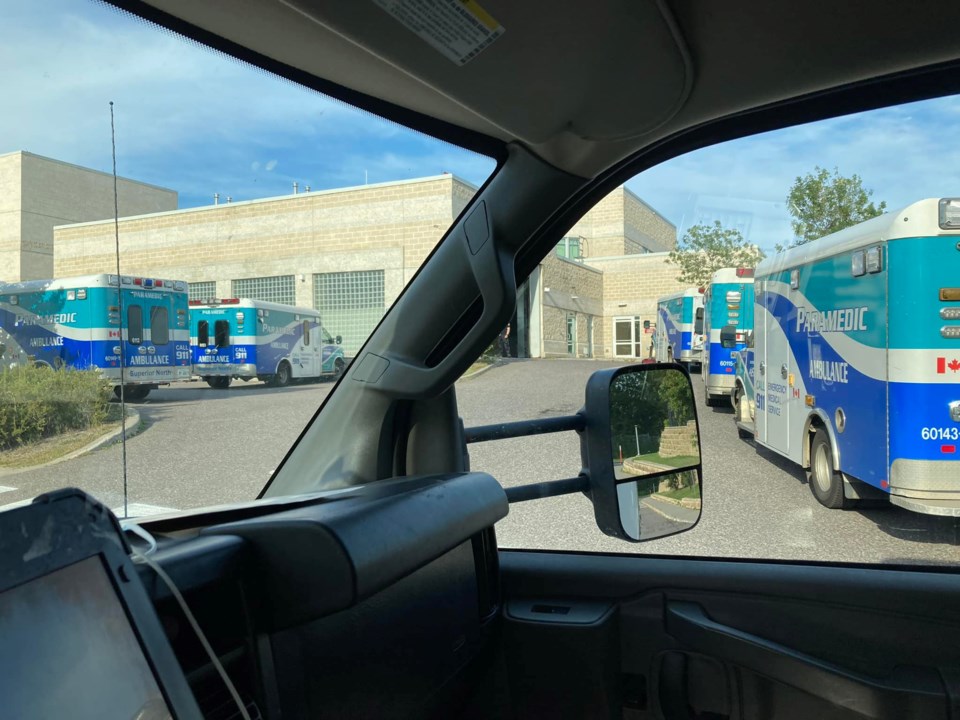THUNDER BAY — The sight of multiple ambulances parked outside the Thunder Bay hospital emergency department reflects the ongoing problems the health care system is facing not just in the city but across Ontario.
On Sunday. the entryway to the emergency department at Thunder Bay Regional Health Sciences Centre was completely filled with Superior North EMS ambulances.
At least six vehicles were visible in a photo taken by an individual who said there were a number of other ambulances that couldn't fit into the picture.
Months ago, Superior North EMS raised concerns about paramedics and ambulances being kept off the road while waiting to offload patients at TBRHSC.
In an interview Wednesday, EMS Chief Wayne Gates said a Code Black was declared when all available ambulances were in use for three hours on Sunday night.
"Thunder Bay Regional does work closely with us and they know that when our ambulances are tied up, they do try to get us cleared as quickly as possible," Gates said.
But he noted that an ambulance that's been cleared may have to be dispatched to another call immediately, meaning that Code Black persists.
Gates said this kind of situation is not that unusual anymore.
He cited several factors, including an average call volume of 80 to 90 per day, which also impacts the hospital emergency department.
Gates said the high call volume is compounded by staffing shortages at Superior North EMS, which means not all ambulances have crews assigned to them.
This may mean that it takes several hours for paramedics to attend to a lower-acuity case such as a person who's experienced severe back pain for a few days, but critical cases are normally picked up pretty quickly, Gates said.
"To date we're fortunate in that we haven't had any serious incidents yet."
Gates said the health care system in Thunder Bay and across the province has changed dramatically in the past few years, resulting in many more people calling 911.
In Thunder Bay, the issue is exacerbated by the fact that the area's population is older than the rest of the province, and that it is growing.
In addition, the city has a high proportion of mental health and addictions cases, compounded by the impact of COVID-19.
"I'm expecting to see well over 40,000 calls this year," Gates said. "Twelve years ago, we were doing 20,000 or 25,000 calls. This is making challenges for us as well as for the emergency department."
He said that in a perfect world, he would be able to hire another 100 paramedics, and TBRHSC would have a lot more beds available.
"At the end of the day, we're all going to have to work together to look at options," Gates said, pointing to possible arrangements to direct patients to facilities other than hospitals when appropriate.
"We can't keep doing this, and we do definitely have to change if we want to retain a 911 service that can respond when needed."
Hospital President and CEO Rhonda Crocker Ellacott said that since February, TBRHSC has seen a nearly 100 per cent increase in the number of patients arriving by ambulance.
She said ambulance visits have risen from a typical 50 to 60 daily to as many as 100.
"That said, we are working very closely with Superior North EMS on strategies to help support ambulance offloads," Crocker Ellacott said.
She pointed to the appointment of an offload delay nurse who takes charge of patients so paramedics can return to the road, and the implementation of a 'wait and sit' program for patients who don't require a stretcher.
"We wouldn't necessarily have spaces in the emergency department proper to take care of these patients, but we have designed offload spaces for those who can stay there and be cared for by our nurse."
Crocker Ellacott said that, regardless of backups, the sickest patients "always get the needed care," and there is no wait at all in these cases.
Despite this and other mitigation measures, though, she said there will be occasions when ambulance crews have to wait with their patients until hospital staff can accommodate them.
